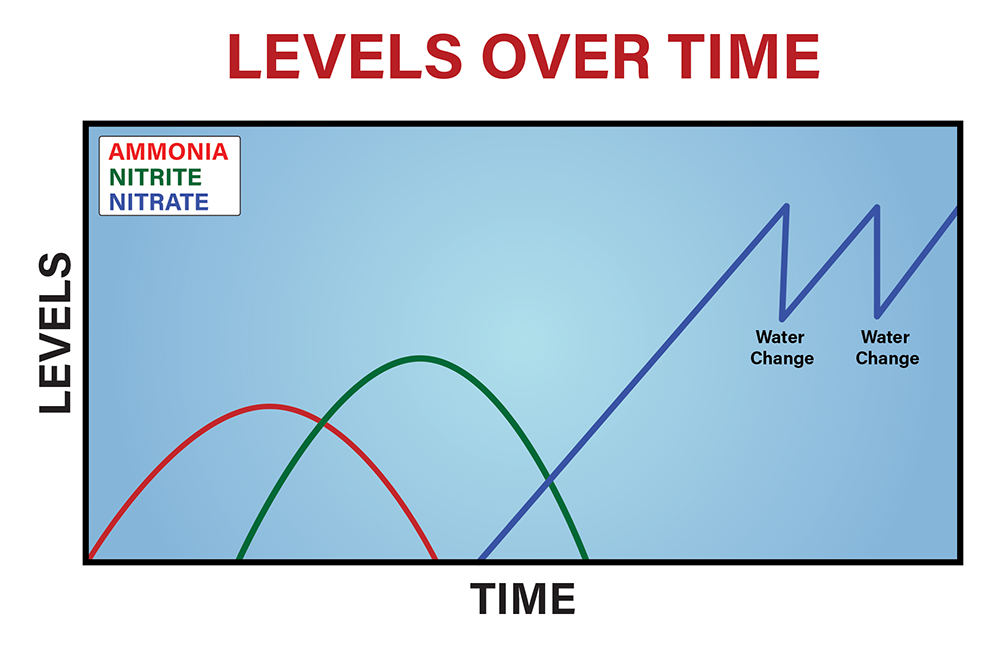There are certain types of anaerobic bacteria, particularly marine species, that can convert nitrate into nitrogen gas, which is then released from the water into the atmosphere. While there's not a particularly effective method of achieving this in freshwater tanks, it's vital for success with marine fish that are much more sensitive to nitrates. With an adequate amount of live rock you can grow colonies large enough to convert most or all of the nitrate that will be produced.
Avoiding Nitrates
While there are methods to remove nitrates that have built up in an aquarium, it is far better to avoid having them build up in the first place.
Don't overstock your aquarium. The more fish you have, the more nitrogenous waste will be produced. If you overfeed your fish, you're going to end up with more nitrate building up in your aquarium. Carefully monitor the health of your aquarium's inhabitants so you don't end up with any fish dying and decomposing, releasing large amounts of ammonia (and ultimately nitrate) into the aquarium.
Even if you have a strong maintenance routine that can keep up with removing the nitrate being produced, it's better to stock and feed a little bit lighter in order to give some buffer room in the case of an emergency.

Cycling Your Aquarium
Tracking Cycle Progression
Knowing the biological processes involved in the nitrogen cycle doesn't do much good if you can't apply that knowledge to setting up your aquarium and don't have a way to know how your cycle is progressing. Monitoring and tracking the progress of your cycle will let you know when it is safe to add fish.
Test Kits
The only way to track the progress of the cycle is to test the water and measure how much ammonia, nitrite, and nitrate are present. Generally speaking, there are two types of test kits available: those that use paper strips and those that use drops.
Of the two, test strips are often easier to use. You simply dip the strip into the water, wait for the strip to change colors, and then compare those colors to the guide. The problem with test strips is that they are often less reliable and are prone to giving false readings.
Test kits that use drops are typically more accurate and reliable than test strips, but require a bit more care in using. You must add a specific amount of aquarium water to a tube or vial, add a certain number of drops to the water, and compare the color of the water to the guide. There is room for user error if you use the wrong amount of water or drops. Certain test kits must be shaken well before using and may require a (sometimes substantial) wait between adding drops and the chemical reactions changing the water to the correct color. But if you follow the directions properly, you will get much better results.
Knowing Where In the Cycle You Are
When you test your water, you can keep a log and track exactly where in the cycle you are.
In general terms, the first thing you will see is a rise in the ammonia levels. Eventually, the ammonia level will start to drop and the nitrite will start to rise. Some time later, the nitrite will fall again and nitrate will rise. When both ammonia and nitrite have reached zero, you know that the tank is cycled.

How high the ammonia and nitrite levels will reach depends on how much ammonia is being introduced and how large your initial colony of beneficial bacteria is. The total length of time that it takes for the cycle to complete can be highly variable, ranging anywhere from a few days to a few months. The larger the starter colony of beneficial bacteria, the faster the cycle will happen. Factors such as temperature and water chemistry can influence the speed of the cycle. How much ammonia is present can also affect the speed, with too much ammonia stalling or stopping the cycle process entirely.
On average, the beneficial bacteria colony size will be able to roughly double each day. Once your tank is fully cycled, if you lose half of your bacteria colony (for example, by replacing filtration media) or double the amount of ammonia being introduced to your aquarium (for example by adding new fish), equilibrium should be reached again in about a day.
However, it is possible to create conditions in a cycled tank where you have to wait for another cycle to occur. Certain medications can kill a large portion of your beneficial bacteria, forcing a new cycle. Performing a particularly heavy cleaning that removes a significant amount of bacteria at the same time you add a large number of fish will overload the remaining bacteria, requiring you to wait for another cycle to happen .
Cycling With Fish
The traditional method of cycling involves adding one or two small, hardy fish to the aquarium to start producing ammonia. Between feeding the fish and the fish's normal waste production, ammonia gets introduced and beneficial bacteria start to grow.
Fish such as goldfish, danios, barbs, and damsels have been the most common options for cycling a new aquarium because they are hardy enough to withstand many of the toxic effects of the nitrogenous waste.
Many people, though, have shifted away from adding live fish to start the cycle. Even hardy fish that are very lightly stocked will be exposed to some amount of ammonia and nitrite and many people will argue that you shouldn't expose them to these harmful chemicals at all. It is also very easy to add too many fish to the un-cycled aquarium to begin with, creating dangerous conditions for your fish and potentially causing many unnecessary problems for both the short and long term.
If you are going to cycle with fish, make sure to only add one or two fish at a time, allowing the beneficial bacteria colonies to develop until the tank is fully cycled before adding more fish. Watch your ammonia and nitrite levels carefully and perform water changes if they start rising too high. Once you have completed the initial cycle, continue to only add small numbers of fish each time so that the bacteria can keep up with the increasing bioload without ever having too much ammonia build up.
Fishless Cycles
More and more people are choosing to use methods to cycle their aquarium that don't involve risking the health of any fish. The bottom line is that in order to get a cycle going, you have to introduce a source of ammonia. There are a few different sources you can choose.
Some people will start with some sort of organic matter. You can add fish food to the aquarium, allowing it to decompose and release ammonia. Some people will use an uncooked shrimp in the same way. The downside of this method is that it can take longer (as you have to wait for the decomposition to happen) and there is little to no control over how much ammonia you are introducing to the aquarium.
A better method is to use pure ammonia that can be found as a cleaning solution. You want to be careful to choose a solution that contains only ammonia and water. Avoid any that are supplemented with additional chemicals or fragrances.
When using ammonia, start with a small amount (just a few drops) and use your test kit to measure how much is being added. Depending on how large of a bacteria colony you want, add enough ammonia to bring the concentration between 2 and 5 parts per million. 2ppm will be sufficient for a somewhat lightly stocked aquarium, while 5ppm should allow you to fully stock it all at once.
Once you've learned how much to add to bring the concentration of ammonia where you want it, you will need to test your aquarium regularly to monitor the progress of your cycle. When the ammonia begins to fall and nitrite begins to rise, keep adding ammonia daily to replenish the desired concentration.
Continue this process until you can add ammonia and have both the ammonia and nitrite levels return to zero within a day. When your bacteria colony is strong enough to accomplish this, you are ready to add fish. Perform a large enough water change to bring your nitrates back down. Congratulations, your aquarium is ready.
Speeding Up the Cycle
As with many parts of fishkeeping, success largely comes down to patience. However, many people don't want to wait, so a number of products and techniques have been developed that are reported to speed up the cycle process.
If you want the absolute fastest way to get a new aquarium cycled, the best way is to introduce a sizeable beneficial bacteria colony from an already established aquarium. The most common method would be to place a filter pad that has been in an established aquarium into your own filter. If the established tank uses an undergravel filter, you can take a cup or two of the gravel from that tank, place it in a mesh bag, and add it to your filter. These methods have the potential to instantly cycle your tank, but they also run the risk of accidentally introducing diseases into your aquarium.
There are a number of commercially bottled products that claim to introduce enough bacteria to significantly increase the speed of the cycle. People have had very mixed experiences with these products. While they likely were all bottled with good amount of beneficial bacteria in them, additional factors such as how long they have been bottled and what sort of temperatures they have been exposed to can affect the health of the original colonies, potentially even killing all of the bacteria in the bottle. There is no way to know how healthy the bacteria contained truly is.
Aside from these additives, you can try to set up your aquarium to encourage faster growth of the beneficial bacteria colonies. Try to keep the temperature of your aquarium between 80 and 85 degrees and the pH around 7.5. Nitrifying bacteria growth will slow down or stop in acidic conditions or when the pH is above around 8.0. Additionally, using an air pump to increase the amount of dissolved oxygen can also help speed up their growth.
|





